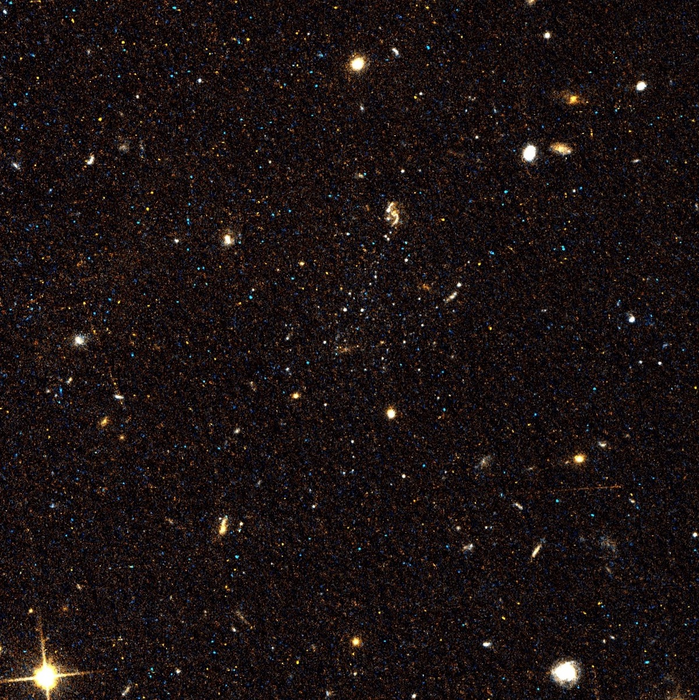According to findings declared on January 11th, 2023, at the 241st meeting of the American Astronomical Society, the breakthrough of the faintest known galaxies present over the neighborhood of the Milky Way could aid researchers in coming up with universal models for how the oldest galaxies were formed in the universe.

Researchers discovered the first ultra-faint dwarf galaxies to be found around a spiral galaxy with the mass of the Milky Way that’s outside of the clustering of galaxies that includes the Milky Way and Andromeda. Pictured is one of the three galaxies, Scl-MM-dw5, with its stars clustered at center. The galaxies are estimated to be 12 billion years old, with nearly all their stars having formed in the early universe. The galaxies were identified from Magellan Megacam observations, then confirmed with deeper Hubble Space Telescope observations. (Image by NASA, HST-GO-15938, PI: Mutlu-Pakdil). Image Credit: NASA, HST-GO-15938, PI: Mutlu-Pakdil.
A research group headed by Burçin Mutlu-Pakdil, currently working as an assistant professor of physics and astronomy at Dartmouth College, determined three ultra-faint dwarf galaxies (UFDs) that are the faintest galaxies seen in the exterior of the Local Group, a bunching of galaxies including the Andromeda and Milky Way.
Having been situated approximately 11.4 million light-years from Earth, the galaxies are evaluated to be 12 billion years old, with almost all their stars formed in the early universe. This was reported by researchers in The Astrophysical Journal.
The galaxies are known to be the first UFDs to be discovered near a spiral galaxy with a mass of the Milky Way, orbiting a galaxy called NGC253, or the Sculptor Galaxy. But their characteristics are in line with UFDs within the Local Group, which could assist researchers in coming up with highly precise models of UFDs generally. The majority of the familiar examples of UFDs are within the Local Group. However, various environments have the potential to impact their formation and evolution, stated Mutlu-Pakdil.
Our work is the necessary first step toward further understanding the faintest galaxies beyond the Local Group, and toward more robustly constraining the demographics of ultra-faint dwarf galaxies.
Mutlu-Pakdil, Assistant Professor, Physics and Astronomy, Dartmouth College
Mutlu-Pakdil added, “We still do not know whether the Local Group UFDs are typical or unusual. To answer this fundamental question, we need to discover more UFDs beyond our local environment and study them in detail.”
UFDs are considered to be the least luminous and chemically evolved galaxies. But they are known to be highly dominated by dark matter, which is the puzzling form of matter thought to form the majority of the universe.
For such reasons, astronomers think UFDs could be spotless fossils of the early universe that can offer the best chance of learning the composition of the universe and the formation of its first galaxies.
Dwarf galaxies are the building blocks of larger galaxies. UFDs are the best place to study galaxy formation on the smallest scales and learn how the smallest dark matter clumps get populated with stars and turn into galaxies.
Mutlu-Pakdil, Assistant Professor, Physics and Astronomy, Dartmouth College
This study was performed as part of the Panoramic Imaging Survey of Centaurus and Sculptor (PISCeS) project, which is a Magellan+Megacam survey targeted at determining new faint satellite galaxies, such as UFDs.
This study was financially supported by the National Science Foundation (grants AST-1821967, 1813708, AST-1814208, AST-1412792, AST-1812856), an NSF Astronomy and Astrophysics Postdoctoral Fellowship (AST-2001663), the Packard Foundation, and the Natural Sciences and Engineering Research Council of Canada.
Journal Reference
Mutlu-Pakdil, B., et al. (2022) Hubble Space Telescope Observations of NGC 253 Dwarf Satellites: Three Ultra-faint Dwarf Galaxies. The Astrophysical Journal. doi.org/10.3847/1538-4357/ac4418.